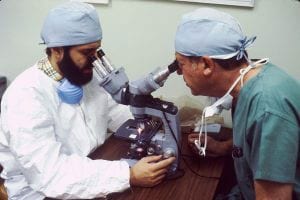In 2019, Rian and Mike Fee celebrated the birth of their son Anderson, who they call Andy. Since birth, Andy has always been such a light in the lives of those around him. He is bubbly, positive, and always smiling. But the Fee family faced an unexpected challenge when Andy was diagnosed with neuroblastoma at just nine months old. According to CBS Philly, a doctor’s appointment showed an abdominal lump which, following an ultrasound and additional testing, came back as cancer.
Of course, the Fee family jumped into action. Andy had surgery to remove the cancer from his body. Then, during recovery, his parents realized that Andy was displaying some concerning symptoms: tremors and uncontrolled eye movements. Another visit to the doctor uncovered a secondary diagnosis of Opsoclonus-myoclonus syndrome (OMS).
You see, OMS can be triggered from viral infections or from neuroblastoma tumors. The family watched as their son regressed developmentally, becoming unable to walk, stand, or talk. But more challenges awaited. As Andy underwent treatment for his OMS, his neuroblastoma tumor returned, even bigger than before. With chemotherapy, physical therapy, and occupational therapy, Andy began walking – though he later relapsed.
Soon, Andy will turn three – and his parents are happy to report that he is doing well. Not only is he still the happy, joyful child he always has been, but he’s once again walking and talking like a champ!
What is Neuroblastoma?
Neuroblastoma is a rare cancer that develops from immature nerve cells in nerve tissues. Though this cancer often begins in the adrenal glands, it may also develop in the chest, neck, spine, or throughout the abdomen. While it may form in older children, neuroblastoma tumors primarily affect children ages five or younger. Symptoms and characteristics vary based on the area of the body that is affected. These may include:
- An abdominal, neck, or chest lump
- Bone pain
- Bulging eyes
- Dark circles around the eyes
- Wheezing
- Abdominal pain
- Fever
- Unintended weight loss
- Changes in bowel habits
- Painless, bluish lumps under the skin (in infants)
- Abdominal distention (in infants)
- Difficulty breathing (in infants)








